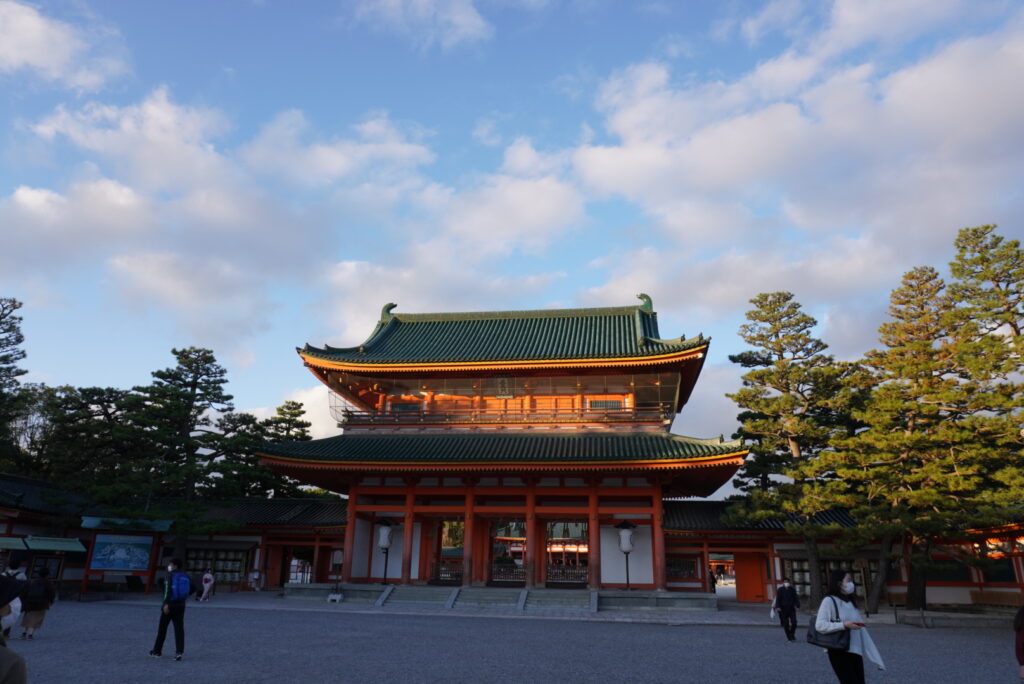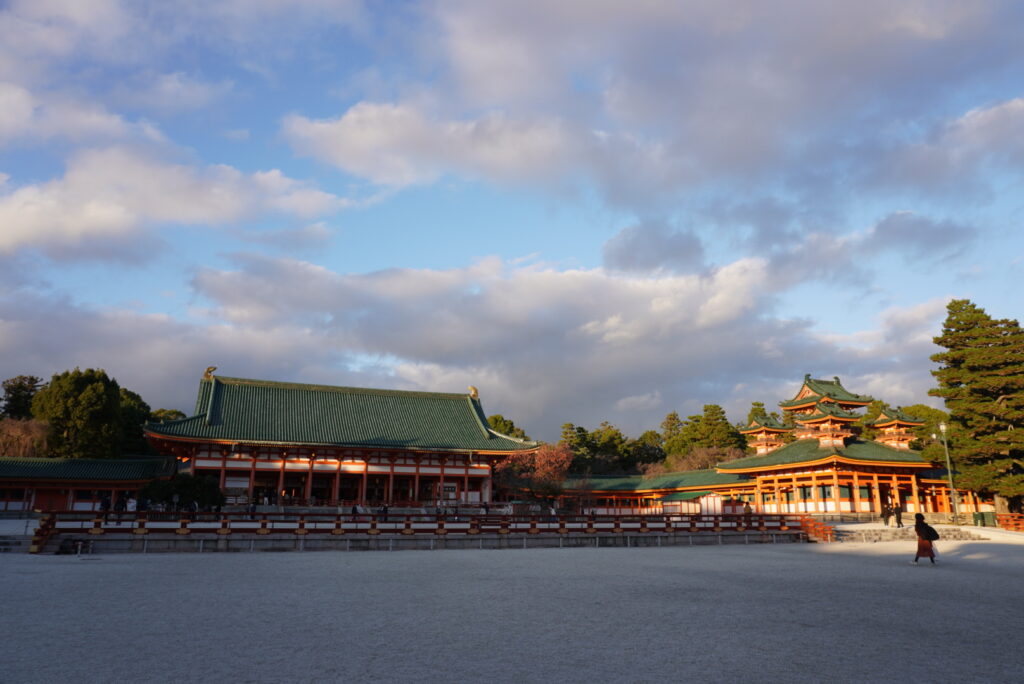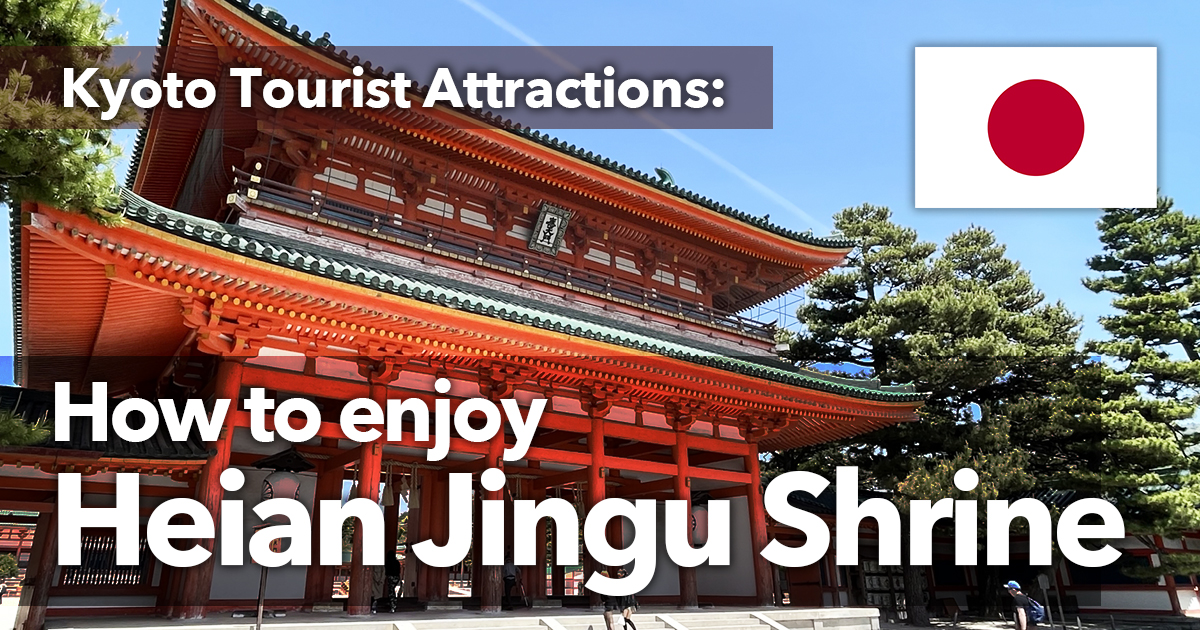INTRODUCTION.

Kyoto is a Japanese city known for its rich history and culture, and one of its most notable tourist attractions is Heian Jingu Shrine. Heian Jingu Shrine is a popular destination for many tourists, as it is a perfect blend of Kyoto’s historical heritage and beautiful gardens.
Heian Jingu was built in 1895 to celebrate Kyoto’s millennial history. Its magnificent temple and expansive garden are a combination of traditional Japanese architecture and the beauty of nature. In particular, cherry blossoms in full bloom adorn the entire shrine in the spring, and the autumn leaves turn brilliant colors in the fall. These seasonal scenes are sure to leave a deep impression on visitors.
Heian Jingu Shrine also hosts a number of cultural events and festivals, which allow visitors to experience traditional Japanese culture. Particularly famous is the Jidai Matsuri (festival of the ages) held every October, which features a spectacular procession that recreates the history from the Heian Period to the Meiji Period.
Thus, Heian Jingu Shrine is a place where visitors can enjoy historical architecture, beautiful nature, and rich cultural events. When visiting Kyoto, be sure to visit this wonderful tourist attraction and enjoy its charms to the fullest.
History and Culture of Tourist Attractions
As its name suggests, Heian Shrine was built to commemorate the Heian period (794-1185), built in 1895 to celebrate Kyoto’s millennium as the capital of Japan. The Heian period lasted from 794 to 1185, a time of great development in Japanese culture and art. The Heian Jingu Shrine plays an important role in preserving the glory of this period for the present day.
The buildings of Heian Jingu were built to resemble the Ouchiura, the inner sanctuary in the center of the former Heian-kyo capital. In particular, the main hall of the shrine is a replica of the Daigoku-den Hall of Heian-kyo, and its magnificent appearance is reminiscent of the splendor of the court culture of the time. The shrine’s vast grounds also include a beautiful garden, where visitors can enjoy the natural beauty of the four seasons.
Heian Jingu is also known as the site of many cultural events and festivals. In particular, the Jidai Matsuri (festival of the ages) held every October attracts many tourists with its spectacular procession that recreates the history from the Heian Period to the Meiji Period. This festival provides an excellent opportunity to gain a deeper understanding of Kyoto’s history and culture.
In addition, Heian Shrine is an important site of traditional Japanese Shintoism. By visiting, you can learn about Shinto teachings and rituals and gain a deeper understanding of Japanese culture.
A visit to Heian Jingu Shrine will give you a real sense of the historical background and cultural character of Kyoto, and will be an unforgettable experience. Visit this wonderful tourist destination and experience the rich history and culture of Japan.
Places to visit
When visiting Heian Shrine, it is important to consider the time of year to visit, as the beauty of each season can be enjoyed. Spring and fall are especially recommended. In spring, the cherry blossoms are in full bloom and the entire shrine is tinged with pink. In autumn, the leaves turn beautiful colors, and the vivid scenery attracts visitors.
Main Highlights
The main attraction of Heian Jingu Shrine is its magnificent temple. The vermilion-lacquered building is a modern-day representation of the court culture of the Heian period (794-1192), and its beauty is overwhelming. The shrine’s extensive garden is also a must-see. The garden is filled with seasonal flowers and trees, offering a different view each time you visit.
One spot of particular note is the Otorii, or Grand Gate. At 24.2 meters high, the Otorii is extremely large and is a symbol of the Jingu Shrine. In addition, the “Jingu Garden” consists of four gardens, each beautifully maintained with a different theme. Ponds, bridges, and waterfalls are among the highlights.
Points to keep in mind when visiting the sightseeing area
First of all, you are expected to visit the shrine quietly. Heian Shrine is a sacred place, and it is important to maintain a quiet environment. Also, do not throw trash in the garden and do not touch plants or buildings. It is also important to take photographs only in authorized areas.

Access
Access to Heian Jingu Shrine is very convenient and can be easily reached from Kyoto Station. Below are the directions from Kyoto Station to Heian Jingu Shrine.
Access from Kyoto Station
The city bus and subway are the most convenient ways to get to Heian Jingu Shrine. You can use the following methods to get there:
Using city bus
- City Bus No. 5: Take City Bus No. 5 (bound for Iwakura) from the Kyoto Station bus stop and get off at the “Kyoto Kaikan Museum Mae” stop. The trip takes about 30 minutes. From the bus stop, it is approximately a 5-minute walk to Heian Shrine.
- City Bus No. 100 (express): Take City Bus No. 100 (express, bound for Ginkakuji) from the Kyoto Station bus stop, and get off at the Okazaki Park Art Museum/Heian Jingu-mae stop. The trip takes about 25 minutes. From the bus stop to Heian Jingu Shrine is about a 5-minute walk.
By Subway
- Kyoto City Subway Karasuma Line: Take the Karasuma Line from Kyoto Station and get off at Karasuma-Oike Station.
- Subway Tozai Line: Transfer to the Subway Tozai Line at Karasuma-Oike Station and get off at Higashiyama Station. The trip takes about 15 minutes. From Higashiyama Station to Heian Shrine is about a 10-minute walk.
By Taxi
- It takes about 15 minutes from Kyoto Station to Heian Shrine by cab. Cabs are also convenient if you have a lot of luggage or if public transportation is congested.
Bicycle rental
- Bicycle rental is also widely used in Kyoto. One option is to rent a bicycle near Kyoto Station and ride it to Heian Shrine. The trip takes about 20 minutes. We recommend this method of transportation as it allows you to enjoy the scenery of Kyoto while sightseeing.
Either way, access to Heian Jingu Shrine is easy and comfortable. Use public transportation, a cab, or a bicycle to visit Heian Jingu Shrine while enjoying the beautiful scenery of Kyoto.
Opening Hours and Admission Fees
When visiting Heian Jingu Shrine, it is advisable to check the opening hours and admission fees in advance to ensure a smooth sightseeing experience. Below are details on the opening hours and admission fees of Heian Jingu Shrine.
Business Hours
The grounds of Heian Jingu are open daily from 6:00 am to 6:00 pm. These hours may vary slightly depending on the season, so we recommend checking the official website for the most up-to-date information before visiting. Especially in winter, it may be open until 5 p.m. due to early sunset.
Admission Fees
Admission to the grounds of Heian Jingu Shrine is free, but an admission fee is required to enter the Shinto Garden. Admission fees for the Shinen Garden are as follows
- Adults (high school students and older): 600 yen
- Children (elementary and junior high school students): 300 yen
The Shinen Garden is a place where visitors can enjoy beautiful scenery in each of the four seasons, and is especially crowded with tourists during the cherry blossom season in spring and the fall foliage season in autumn. Please visit to enjoy the beauty and tranquility of nature.
Special Events
Various special events are held throughout the year at Heian Jingu Shrine. Of particular note is the Jidai Matsuri (Festival of the Ages), held annually on October 22. At this festival, visitors can see a gorgeous procession that recreates the history from the Heian period to the Meiji period. During the event, hours of operation may be extended and special admission fees may be set, so it is advisable to check in advance.
Summary
Heian Jingu Shrine is an iconic tourist attraction in Kyoto, with its magnificent architecture and beautiful garden. The cherry blossoms in spring and the autumn leaves in fall are especially beautiful and worth visiting. The shrine garden is fee-based and offers seasonal scenery. It is easily accessible and is within walking distance from Higashiyama Station. Access from Narita and Haneda airports is also convenient. Please visit Heian Jingu Shrine and enjoy the history and culture of Kyoto.



